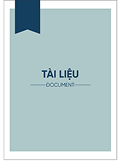Tài liệu
The sustainability of Swedish fiscal policy: a re-examination

Xem mô tả
154
Xem & Tải
1
Tóm tắt
Purpose – This study reexamines the sustainability of fiscal policy in Sweden. Design/methodology/approach – To test the sustainability of fiscal policy, two approaches are used; the methodology of Kejriwal and Perron (2010), testing for multiple structural changes in a cointegrated regression model and time-varying cointegration test of Bierens and Martins (2010), and Martins (2015). Findings – Using the first approach of testing for multiple structural changes in a cointegrated regression model, the results indicate that government spending and revenue are cointegrated with two breaks. An estimation of a two-break long-run model shows that the slope coefficient increases from 0.678 to 0.892 from the first to the second regime, implying that fiscal deficits were weakly sustainable in the first two regimes, from 1800 to 1943, and from 1944 to 1974. Further, results from time-varying cointegration test indicate that cointegration between spending and revenue in Sweden is time-varying. Fiscal deficits were found to be unsustainable for the periods 1801–1811, 1831–1838, 1853–1860 , 1872–1882, 1897–1902, 1929–1940 and 1976– 1982 and weakly sustainable over the rest of the study period. Research limitations/implications – A number of implications arise from this study: (1) Accounting for breaks in cointegration analysis and in the estimation of the level relationship between spending and revenue is very important because ignoring breaks may lead to an overestimated slope coefficient and hence a bias on the magnitude of fiscal deficit sustainability. (2) In testing for cointegration between spending and revenue, assuming a constant cointegrating slope when it is actually time-varying can also be misleading because deficits can be sustainable for a period of time and unsustainable over another period. Originality/value – The contribution of this study is three-fold; first, the study uses a long series of annual data spanning over a period of two centuries, from 1800 to 2011. Second, because of the importance of structural change in economics, to examine the existence of a level relationship between spending and revenue, the study uses the methodology of Kejriwal and Perron (2010) to test for multiple structural changes in a cointegrated regression model, as well as time-varying cointegration of Bierens and Martins (2010) and Martins (2015).
Mô tả
economic management and policy
Tác giả
Arcade Ndoricimpa
Người hướng dẫn
Nơi xuất bản
Nhà xuất bản
Kinh Tế Quốc Dân
Năm xuất bản
2021
ISBN
1981-0020
ISSN
Từ khóa chủ đề
Fiscal deficits , Multiple breaks , Cointegration , Time-varying cointegration , Sweden
Trích dẫn
Bộ sưu tập
Tệp tin

10-1108_JED-04-2020-0045.pdf
D:\NEU_DSpace\tapchitienganh
Dung lượng: 250.06 KBĐịnh dạng: pdf
Lượt xem: 0 Lượt tải: 1
